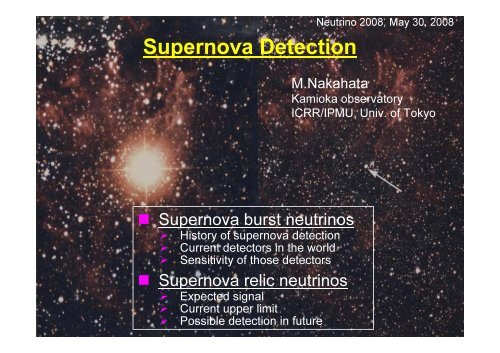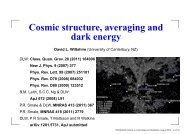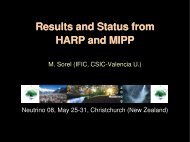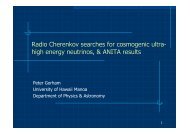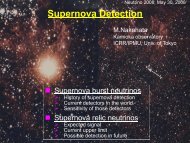Create successful ePaper yourself
Turn your PDF publications into a flip-book with our unique Google optimized e-Paper software.
<strong>Supernova</strong> <strong>Detection</strong><br />
Neutrino 2008, May 30, 2008<br />
M.Nakahata<br />
Kamioka observatory<br />
ICRR/IPMU, Univ. of Tokyo<br />
<strong>Supernova</strong> burst neutrinos<br />
<br />
<br />
<br />
History of supernova detection<br />
Current detectors in the world<br />
Sensitivity of those detectors<br />
<strong>Supernova</strong> relic neutrinos<br />
<br />
<br />
<br />
Expected signal<br />
Current upper limit<br />
Possible detection in future
SN1987A: supernova at LMC(50kpc)<br />
Kamiokande-II IMB-3 BAKSAN<br />
<br />
<br />
<br />
<br />
<br />
Feb.23, 1987 at 7:35UT<br />
Kam-II (11 evts.)<br />
IMB-3 (8 evts.)<br />
Baksan (5 evts.)<br />
24 events total<br />
Total Binding Energy<br />
95 % CL<br />
Contours<br />
Theory<br />
<br />
<br />
<br />
from G.Raffelt<br />
_<br />
Spectral ν e<br />
Temperature
Have you seen Large Magellanic Cloud(LMC)<br />
I visited Mt. John Observatory yesterday, and saw LMC with the naked eye.<br />
(Thanks to Prof.Itow (Nagoya Univ.) ).<br />
MOA 1.8m telescope<br />
(Microlensing<br />
Observation in<br />
Astrophysics)<br />
Tarantula Nebula by<br />
MOA on May 28, 2008<br />
We are here.<br />
Mt. John Observatory<br />
In 1987 by<br />
AAO
History of supernova detectors<br />
1<br />
9<br />
8<br />
0<br />
1<br />
9<br />
8<br />
1<br />
1<br />
9<br />
8<br />
2<br />
1<br />
9<br />
8<br />
3<br />
1<br />
9<br />
8<br />
4<br />
1<br />
9<br />
8<br />
5<br />
1<br />
9<br />
8<br />
6<br />
1<br />
9<br />
8<br />
7<br />
1<br />
9<br />
8<br />
8<br />
1<br />
9<br />
8<br />
9<br />
1<br />
9<br />
9<br />
0<br />
1<br />
9<br />
9<br />
1<br />
1<br />
9<br />
9<br />
2<br />
1<br />
9<br />
9<br />
3<br />
1<br />
9<br />
9<br />
4<br />
1<br />
9<br />
9<br />
5<br />
1<br />
9<br />
9<br />
6<br />
1<br />
9<br />
9<br />
7<br />
1<br />
9<br />
9<br />
8<br />
1<br />
9<br />
9<br />
9<br />
2<br />
0<br />
0<br />
0<br />
2<br />
0<br />
0<br />
1<br />
2<br />
0<br />
0<br />
2<br />
2<br />
0<br />
0<br />
3<br />
2<br />
0<br />
0<br />
4<br />
2<br />
0<br />
0<br />
5<br />
2<br />
0<br />
0<br />
6<br />
2<br />
0<br />
0<br />
7<br />
2<br />
0<br />
0<br />
8<br />
BAKSAN (330t liq.sci.)<br />
IMB (7000t water)<br />
Kamiokande (2140t water)<br />
LSD(90t liq. sci.)<br />
SN1987a<br />
LVD (3301000t liq. sci.)<br />
Super-Kamiokande (32000t water)<br />
Amanda/IceCube<br />
Detectors in the world have been monitoring<br />
galactic supernova for almost 30 years.<br />
SNO (1000t D 2 O)<br />
KamLAND(1000t liq.sci.)<br />
Borexino(300t liq.sci.)
<strong>Supernova</strong> detectors in the world<br />
(running and near future experiments)<br />
Super-K<br />
Borexino<br />
LVD<br />
Baksan<br />
SNO+<br />
(beginning construction)<br />
HALO<br />
KamLAND<br />
(proposed)<br />
IceCube
Distance to Galactic supernova<br />
Mirizzi, Raffelt and Serpico, JCAP 0605,012(2006),<br />
astro-ph/0604300<br />
Based on birth location of neutron stars<br />
Type Ia<br />
Core collapse type<br />
mean: 10.7 kpc<br />
r.m.s.: 4.9 kpc<br />
7% probability<br />
< 3.16 kpc<br />
> x10 statistics<br />
0 10kpc 20kpc<br />
16%<br />
probability<br />
< 5 kpc<br />
> x 4 statistics<br />
3% probability<br />
> 20 kpc<br />
< 1/4 statistics<br />
If a detector is sensitive up to<br />
20kpc, it covers 97% of our<br />
galaxy.
The Baksan underground scintillation telescope<br />
Total number of standard detectors…………..3150<br />
Total target mass…………………….…...330 tons of oil-based scintillator<br />
~100 ν e p e + n events expected for 10 kpc SN.<br />
Running since 1980 with ~90% live time.<br />
E.N.Alexeyev, L.N.Alexeyeva, astro-ph/0212499<br />
Criteria of serious candidate: ≥ 9 events/20sec in inner 130ton detectors.<br />
(sensitive up to ~20kpc)<br />
No signal (except for SN1987A) over the 28 calender years
LVD detector<br />
LVD consists of an array of<br />
840 counters, 1.5 m 3 each.<br />
Total target:<br />
1000 t of C n H 2n<br />
900 t of Fe<br />
4MeV threshold<br />
With
LVD on-line sensitivity<br />
W.Fulgione, poster #90<br />
LVD can select burst candidates<br />
• on-line,<br />
• with low model-dependence and<br />
• with severe noise rejection<br />
factors.<br />
N.Yu. Agafonova et al. Astroparticle Physics,<br />
Vol 28/6 pp 516-522 -in press-<br />
• LVD can identify, on-line, ν-bursts occurring in the whole Galaxy<br />
(D 90%. Such a sensitivity is preserved even<br />
if the detector is running with only 1/3 of its total mass and standalone,<br />
with a severe noise rejection factor (
Super-K: Expected number of events<br />
Neutrino flux and energy spectrum from Livermore simulation<br />
(T.Totani, K.Sato, H.E.Dalhed and J.R.Wilson, ApJ.496,216(1998))<br />
~7,300 ν e +p events<br />
~300 ν+e events<br />
~360 16 O NC γ events<br />
~100 16 O CC events<br />
(with 5MeV thr.)<br />
for 10 kpc supernova
Super-K: Time variation measurement by ν e +p<br />
Assuming a supernova at 10kpc.<br />
ν e p e + n events give direct energy information (E e = E ν – 1.3MeV).<br />
Time variation of event rate<br />
Time variation of mean energy<br />
Enough statistics to discuss model predictions
Super-K:<br />
ν+e scattering events<br />
events/bin<br />
50<br />
40<br />
Energy = 5-10 MeV<br />
ν+e<br />
events/bin<br />
100<br />
80<br />
Energy = 10-20 MeV<br />
ν+e<br />
SN at 10kpc<br />
30<br />
60<br />
events/bin<br />
20<br />
10<br />
0<br />
-1 -0.5 0 0.5 1<br />
cos(θ SN<br />
)<br />
60<br />
Energy = 20-30 MeV<br />
50<br />
40<br />
30<br />
20<br />
10<br />
νe+p<br />
ν+e<br />
νe+p<br />
events/bin<br />
0<br />
-1 -0.5 0 0.5 1<br />
cos(θ SN<br />
)<br />
40<br />
20<br />
νe+p<br />
0<br />
-1 -0.5 0 0.5 1<br />
cos(θ SN<br />
)<br />
25<br />
Energy = 30-40 MeV<br />
22.5<br />
20<br />
ν+e<br />
17.5<br />
15<br />
12.5<br />
10<br />
7.5<br />
5<br />
2.5 νe+p<br />
0<br />
-1 -0.5 0 0.5 1<br />
cos(θ SN<br />
)<br />
Direction of supernova can<br />
be determined with an<br />
accuracy of ~5 degree.<br />
Spectrum of ν+e events<br />
can be statistically<br />
extracted using the<br />
direction to supernova.<br />
Neutrino flux and spectrum<br />
from Livermore simulation
Super-K: Neutronization burst<br />
(e - +pn+<br />
n+ν e )<br />
SN at 10kpc<br />
Neutrino flux and spectrum from Livermore simulation<br />
Event rate of ν e +p events<br />
Event rate of neutronization burst<br />
(forward peaked ν+e scattering events)<br />
No oscillation<br />
Normal P H =1 or<br />
Inverted hierarchy<br />
Normal hierarchy P H =0<br />
P H : crossing probability at H resonance<br />
(P H =0: adiabatic)<br />
Number of events from neutronization burst is 0.9~6 events for SN@10kpc.<br />
ν e<br />
p events during this 10msec is about 8 - 30 events.<br />
N.H. +adiamacitc case: neutronization=0.9ev., ν e<br />
p = 14 ev.(1.4 for SN direction).
IceCube: The Giga-ton Detector Array<br />
IceTop<br />
Design Specifications<br />
InIce<br />
AMANDA<br />
19 Strings<br />
677 Modules<br />
AMANDA construction: 1997 - 2000<br />
IceCube construction: 2005 - 2011<br />
• Fully digital detector concept<br />
• Number of strings – 75<br />
• Number of surface tanks – 160<br />
• Number of DOMs – 4820<br />
• Instrumented volume – 1 km 3<br />
• Angular resolution < 1.0°<br />
total of 40 strings were<br />
deployed so far.<br />
<strong>Supernova</strong> neutrinos coherently<br />
increase the PMT signal rate.
IceCube as MeV ν detector<br />
10 kpc to SN<br />
Simulation based on Livermore model<br />
Advantage:<br />
high statistics<br />
(0.75% stat. error<br />
@ 0.5s and 100ms bins)<br />
Good for fine time<br />
structures (noise low)!<br />
Disadvantage:<br />
no pointing<br />
no energy<br />
intrinsic noise<br />
Galactic<br />
Center<br />
IceCube<br />
LMC<br />
SMC<br />
Significance:<br />
Galactic center: ~200 σ<br />
LMC : ~5 σ<br />
SMC : ~4 σ<br />
Amanda<br />
L.Koepke and A.Piegsa
Single volume liq. scintillator detectors<br />
KamLAND Borexino SNO+<br />
300ton liq.sci.<br />
Running since 2007.<br />
1000ton liq.sci.<br />
Running since 2002.<br />
1000ton liq.sci.<br />
completing final design and<br />
beginning initial construction.
Liquid scinitillator detectors<br />
Expected number of events(for 10kpc SN)<br />
Events/1000 tons<br />
Inverse beta( ν e +p→e + +n) : ~300 events<br />
Spectrum measurement with good energy resolution, e.g. for<br />
spectrum distortion of earth matter effect.<br />
CC on 12 C (ν e + 12 C→e+ 12 N( 12 B)) : ~30 events<br />
Tagged by 12 N( 12 B) beta decay<br />
Electron scattering (ν+e - → ν+e - ) : ~20 events<br />
NC γ from 12 C (ν+ 12 C→ν+ 12 C+γ): ~60<br />
events<br />
Total neutrino flux, 15.11MeV mono-energetic gamma<br />
ν+p scattering( ν+p→ ν+p): ~300<br />
events<br />
Spectrum measurement of higher energy component.<br />
Independent from neutrino oscillation.
ν+p elastic signal( ν+p→ ν+p) at liq. Scintillator<br />
detectors Beacom, Farr, and Vogel, PRD66, 033001(2002)<br />
Expected spectrum<br />
Sensitivity of temperature<br />
measurement<br />
ν e<br />
ν e<br />
ν µ<br />
ν µ<br />
ν τ<br />
ν τ<br />
Solid: s um of all<br />
~300 events/kt above 200keV<br />
~150 events/kt above 500keV<br />
Determine original ν µ , ν µ , ν τ , ν τ temperature<br />
with ~10% accuracy.<br />
(free from neutrino oscillation.)<br />
Current Borexino threshold: 200keV<br />
Current KamLAND threshold: 600~700keV(will be lowered after 2008 distillation.)
HALO - a Helium and Lead Observatory<br />
SNO 3 He neutron detectors with lead target<br />
C.Virtue, poster #93<br />
CC:<br />
NC:<br />
HALO-1 will use an available 76 tonnes of Pb<br />
In HALO-1 for a SN @ 10kpc † ,<br />
• Assuming FD distribution with T=8 MeV for ν µ ’s, ν τ ’s.<br />
• 65 neutrons through ν e charged current channels<br />
• 20 neutrons through ν x neutral current channels<br />
~ 85 neutrons liberated;<br />
with ~50% of detection efficiency, ~40 events expected.<br />
HALO-2 is a future kt-scale detector
SuperNova Early Warning System<br />
snews.bnl.gov<br />
Details:<br />
Individual supernova-sensitive experiments send burst<br />
datagrams to SNEWS coincidence computer at<br />
Brookhaven National Lab(backup at U. of Bologna)<br />
Email alert to astronomers if coincidence in 10 seconds<br />
Participating experiments:<br />
arXiv:astro-ph/0406214<br />
arXiv:0803.0531<br />
K.Scholberg<br />
Super-<br />
Kamiokande<br />
(Japan)<br />
Large<br />
Volume<br />
Detector<br />
(Italy)<br />
AMANDA/<br />
IceCube<br />
(South Pole)<br />
SNO<br />
(Canada)<br />
until end of 2006
<strong>Supernova</strong> Relic Neutrinos<br />
S.Ando, Astrophys.J.607:20-31,2004.<br />
S.Ando,<br />
NNN05
<strong>Supernova</strong> Relic Neutrinos<br />
Neutrino Flux (/cm2 /sec /MeV)<br />
10 6<br />
10 5<br />
10 4<br />
10 3<br />
10 2<br />
10<br />
1<br />
10 -1<br />
10 -2<br />
10 -3<br />
10 -4<br />
10 -5<br />
10 -6<br />
Reactor ν (ν e )<br />
Solar 8 B (ν e )<br />
Solar hep (ν e )<br />
Constant SN rate (Totani et al., 1996)<br />
Totani et al., 1997<br />
Hartmann, Woosley, 1997<br />
Malaney, 1997<br />
Kaplinghat et al., 2000<br />
Ando et al., 2005<br />
Lunardini, 2006<br />
Fukugita, Kawasaki, 2003(dashed)<br />
SRN predictions<br />
(ν e fluxes)<br />
Atmospheric ν e<br />
Neutrino Energy (MeV)<br />
Expected number SRN events<br />
0.8 -5.0 events/year/22.5kton<br />
(10-30MeV)<br />
0.3 -1.9 events/year/22.5kton<br />
(18-30MeV)<br />
Large target mass and high<br />
background reduction are<br />
necessary.<br />
10 7 0 10 20 30 40 50 60 70 80
SRN Flux upper limit so far<br />
C. Lunardini, astro-ph/0610534<br />
−1<br />
Flux (MeV cm s )<br />
−1<br />
−2<br />
KamLAND<br />
SNO<br />
SuperKamiokande<br />
SuperKamiokande+oscillations, indirect<br />
SuperKamiokande<br />
Ando et al. 2002 flux<br />
as a reference<br />
ν e limit<br />
ν e limit
Super-K results so far<br />
Flux limit VS predicted flux<br />
4<br />
3. 5<br />
3<br />
2. 5<br />
2<br />
1. 5<br />
( E>18MeV)<br />
SK-II limit = 3.68 /cm 2 /sec<br />
pr eliminar y<br />
SK-I limit = 1.25 /cm 2 /sec<br />
Combined limit = 1.08 /cm 2 /sec<br />
1<br />
0. 5<br />
0<br />
Const ant<br />
SN r at e<br />
( Tot ani et<br />
al . 1996)<br />
Tot ani et<br />
al . 1997 Mal aney et<br />
al . 1997)<br />
Har t mann<br />
et al .<br />
1997)<br />
Kapl i nghat<br />
et al .<br />
2004<br />
Ando et<br />
al . 2005<br />
Fukugi t a<br />
et al .<br />
Lunardi ni<br />
et al .<br />
2003<br />
2006<br />
T.iida, poster #90.5
Energy spectrum of SK-I and SK-II<br />
(>18MeV)<br />
SK-I (1496days)<br />
SK-II(791 days)<br />
90% CL limit<br />
of SRN<br />
Total<br />
background<br />
Atmospheric ν µ →<br />
invisible µ → decay e<br />
Events/4MeV<br />
Atmospheric ν µ →<br />
invisible µ → decay e<br />
Atmospheric ν e<br />
Atmospheric ν e<br />
Spallation background<br />
Energy (MeV)<br />
Observed spectrum is consistent with estimated background.<br />
Search is limited by the invisible muon background.<br />
T.iida, poster #90.5
Neutron tagging in water<br />
ν e p<br />
e +<br />
Cherenkov detector<br />
n<br />
Gd<br />
p<br />
Positron and gamma ray<br />
vertices are within ~50cm.<br />
ν e can be identified by delayed coincidence.<br />
γ<br />
γ<br />
GADZOOKS!<br />
n+Gd →~8MeV γ<br />
∆T = ~30 µsec<br />
Add 0.2% GdCl 3 in water<br />
(J.Beacom and M.Vagins)<br />
Phys.Rev.Lett.93:171101,2004<br />
Another possibility<br />
n+p→d + γ<br />
2.2MeV γ-ray<br />
∆T = ~ 200 µsec<br />
Number of hit PMT is<br />
about 6 in SK-III
Test neutron tagging at Super-K<br />
GdCl 3 test vessel<br />
0.2 % GdCl 3<br />
Solution<br />
BGO<br />
5 cm<br />
18 cm<br />
BGO<br />
Am/Be<br />
13 cm<br />
18 cm<br />
This apparatus deployed in the SK tank.<br />
BGO signal (prompt signal (large and long time pulse))<br />
α + 9 Be → 12 C * + n<br />
12<br />
C* → 12 C + γ(4.4 MeV)<br />
n + p → …… → n + Gd → Gd + γ (totally 8 MeV)<br />
Look for Cherenkov<br />
signal (delayed signal)<br />
H.Watanaba, poster #94
Cherenkov signal of Gd gamma rays<br />
Time from prompt<br />
Energy spectrum<br />
Number of Events<br />
τ = 23.7±1.7µs<br />
Number of Events<br />
45<br />
40<br />
35<br />
30<br />
25<br />
20<br />
Black: Data<br />
Red: MC<br />
15<br />
0<br />
100µs<br />
[msec]<br />
10<br />
5<br />
160<br />
140<br />
120<br />
100<br />
80<br />
60<br />
40<br />
20<br />
Vertex position<br />
92% within 2m<br />
0<br />
0 2 4 6 8 10 12<br />
Recon. Energy [MeV]<br />
Measured time, vertex and energy<br />
distributions are as expected from the<br />
MC simulation.<br />
0<br />
0 200 400 600 800 1000<br />
dR [cm]<br />
H.Watanaba, poster #94
Tagging efficiency and BG reduction<br />
Selection criteria of delayed signal:<br />
(1) Vertex position within 2m<br />
(2) Energy of delayed signal > 3MeV<br />
(3) Time after the prompt within 60µsec.<br />
(4) Ring pattern cuts<br />
Selection efficiency is ~74%.<br />
With 90% capture eff. by 0.2% Gd,<br />
Tagging efficiency is 67%<br />
While the chance coincidence<br />
prob. is estimated to be ~2×10 -4<br />
It almost satisfy the requirement to<br />
remove remaining spallation background<br />
at 10 MeV.<br />
H.Watanaba<br />
poster #94<br />
Number of events/day/22.5kt/0.5MeV<br />
SRN<br />
predictions<br />
10 4<br />
10 3<br />
10 2<br />
10<br />
SK-I final data sample<br />
1<br />
SSM(BP2004) * 0.4<br />
(efficiencies are considered)<br />
6 8 10 12 14 16 18 20<br />
Energy (MeV)<br />
10 -1<br />
10 -2<br />
10 -3<br />
10 -4<br />
Energy spectrum<br />
92 %<br />
MC simulation<br />
Recon. Energy [MeV]<br />
Current single BG rate<br />
(mainly due to spallation<br />
and solar 8 B)
Possibility of SRN detection<br />
Relic model: S.Ando, K.Sato, and T.Totani, Astropart.Phys.18, 307(2003) with flux revise in<br />
NNN05.<br />
If invisible muon background can be reduced by neutron tagging<br />
events/10years/2MeV<br />
10<br />
9<br />
SK10 years (ε=67%)<br />
8<br />
relic+B.G.(inv.mu 1/5)<br />
7<br />
6<br />
5<br />
4<br />
3<br />
2<br />
B.G. inv.mu(1/5)<br />
1<br />
atmsph. ν – e<br />
0<br />
10 15 20 25 30 35 40 45 50<br />
Visible energy (MeV)<br />
Assuming invisible muon B.G. can<br />
be reduced by a factor of 5 by<br />
neutron tagging.<br />
Assuming 67% detection efficiency.<br />
By 10 yrs SK data,<br />
Signal: 33, B.G. 27<br />
(E vis =10-30 MeV)
Items to be studied before introducing<br />
gadolinium to SK<br />
Effect to water transparency<br />
Water transparency should be long enough to do various physics<br />
at SK.<br />
Water purification system<br />
Current water purification system remove ions. So, it must be<br />
modified to purify water without removing gadolinium.<br />
Material effects<br />
Corrosion by gadolinium solution should be checked.<br />
How to introduce/remove<br />
How to mix gadolinium uniformly in the tank. How<br />
quickly/economically/completely can the Gd be removed<br />
Ambient neutron level in the tank<br />
Does it cause significant increase singles in trigger rate[for solar<br />
analysis]<br />
In order to study those things, we will construct a test tank<br />
(6~10m size) in the Kamioka mine.
Conclusions<br />
• <strong>Supernova</strong> burst neutrinos<br />
If a galactic supernova happens in near future,<br />
– Many ν e events are expected.<br />
– Various new types of signals (e.g. neutral current signals)<br />
are expected.<br />
• <strong>Supernova</strong> relic neutrinos<br />
– Will give us star formation history.<br />
– Expected event rate is small and we need large volume<br />
detector at least as large as Super-K.<br />
– G&D for the gadolinium project is going on.<br />
Acknowledgements to<br />
L.Koeke, G.Bellini, P.Vogel, W.Fulgione, K.Inoue, S.Enomoto, M.Chen, S.Yen,<br />
C.Virtue, A.Piegsa, J.Heise, N.McCauley, E.Alexeyev, S.Yen, K.Scholberg,<br />
J.Learned, S.Dye, W.Kropp, M.Vagins, M.Smy, H.Watanabe, T.Iida, M.Ikeda


